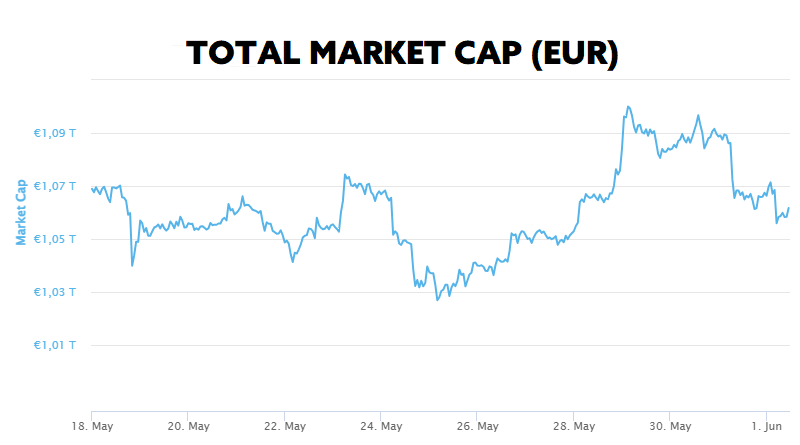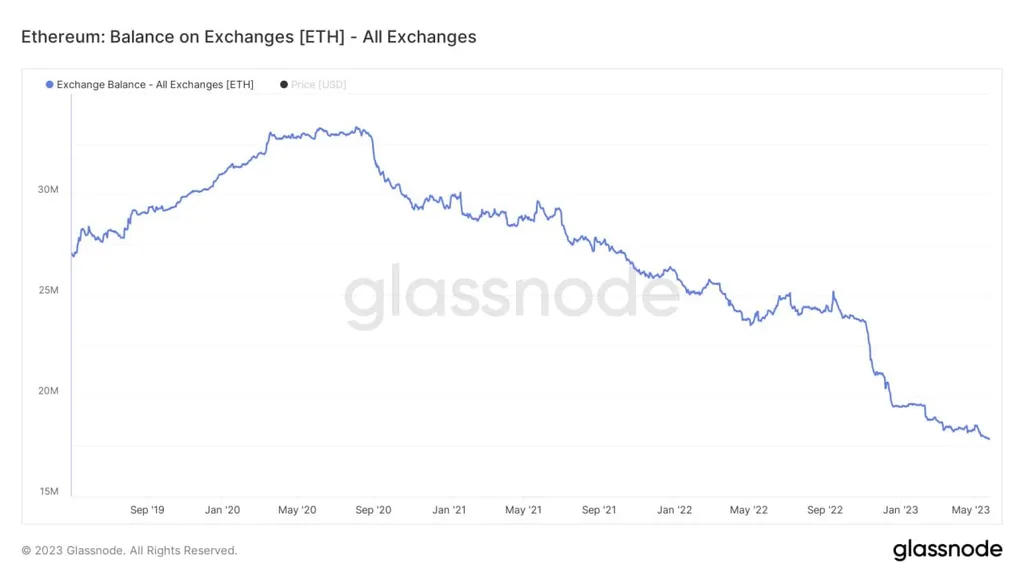The Number of Cryptocurrencies on Exchanges Is Declining – Market Info
Over the past two weeks, the total market capitalisation exceeded €1.06 trillion. The increase in market capitalisation over a 14-day period is 0.95%. The price of Bitcoin has fallen by 0.39% over the last 14 days to a current value of over €25,200. Bitcoin’s dominance is currently around 46.1%.

Source: Coinmarketcap
The Number of Cryptocurrencies on Exchanges Is Declining
The amount of Bitcoins and Ether on exchanges is reaching record lows, according to data from analytics platform Glassnode. The amount of these assets held by users on exchanges has reached a 5-year low and continues to decline.
According to available data, there are currently approximately 17.8 million Ether (ETH) held on exchanges, representing roughly 14.85% of the total circulating stock of ETH. While this number may still seem relatively high to some, it is a significant decrease from 2020, when up to 30% of the total circulating stock of ETH was held on exchanges.

Source: Glassnode
The most popular cryptocurrency, Bitcoin, is in a similar position. According to available on-chain data, only 2.23 million BTC are currently held on exchanges, which is roughly only 11% of the total circulating supply. The amount of bitcoins on exchanges has been steadily declining and is currently at levels last seen in March 2018.
When cryptocurrencies like Bitcoin or Ethereum leave centralised exchanges, investors see this as a bullish signal. Fewer assets are available for sale on exchanges, reducing the selling pressure on those assets. Conversely, the influx of cryptocurrencies onto exchanges is seen as a bearish signal, as it suggests that investors are moving their funds onto exchanges to sell them.
A closer look at the data shows that a significant decline in asset holdings on exchanges occurred in November and December 2022 following the collapse of the FTX crypto exchange. Shortly after FTX’s collapse, a huge outflow of assets from other exchanges, such as Coinbase and Binance, followed due to fears of a possible chain reaction.
The most recent drop in ETH balances on exchanges in May is significantly related directly to staking. Indeed, the amount of ETH staked has risen from 19.3 million before the Shapell update to 21.2 million, with many investors pulling their funds from exchanges and starting to create their own validation nodes or staking ETH via liquid staking protocols. Source

BTC Mining Tax Has Been Blocked
On the night of Sunday to Monday, news circulated on the internet regarding the preliminary agreement between US President Joe Biden and Speaker of the House of Representatives Kevin McCarthy on the US debt ceiling. However, one very important part of the agreement includes a clause concerning bitcoin miners.
The Biden administration has been trying to push through a number of proposals relating to the taxation of miners for some time. One of the most prominent proposals was an excise tax known as the Digital Asset Mining Energy, which aimed to impose a 30% tax on cryptocurrency mining firms. The Biden administration has consistently pushed this as a necessary step to limit the environmental and social damage caused by cryptocurrency mining operations.
However, according to the latest information, the Biden-McCarthy agreement on the debt ceiling has blocked this proposal. This was confirmed on Twitter by US Congressman Warren Davidson, who wrote that “one of the victories is blocking proposed taxes.”
The proposal regarding the taxation of miners has increasingly been the target of harsh criticism in recent weeks. Bitcoin and its mining have been defended by Democratic presidential candidate Robert F. Kennedy Jr., who said on Twitter that “bitcoin mining uses about the same as video games, and no one is calling for a ban on those.”
Republican Senator Cynthia Lummis also denounced the proposal at the recent Bitcoin 2023 conference, arguing that a thriving bitcoin mining industry is not only a national security issue but also an energy security issue. Thus, it seems that miners will not be affected by the proposed law, so miners will be able to continue their operations without fear of excessive taxation. Source
Bitcoin Network Has the First BRC-20 Stablecoin
Stable, a Stablecoin-as-a-Service (SCaaS) service provider and fiat on/off-ramp infrastructure provider for Web3 projects founded back in 2018, has launched a stablecoin called Stable USD (#USD) as a BRC-20 token directly on Bitcoin.
BitFi, or decentralised finance on the bitcoin network, is supported by bitcoin’s Ordinals protocol, which was introduced earlier this year thanks to Taproot’s innovations. BRC-20 tokens use the ability to write data directly into satoshi currency units. With this feature, individual satoshi can represent different assets, whether digital art, tokens or stablecoins.
According to a tweet from Stable, the Stable USD is backed by 1:1 collateral held by its custodian, Prime Trust, at banks insured by the Federal Deposit Insurance Corporation (FDIC). The custodian is subject to external audits from The Network Firm, a digital asset audit firm. The goal is to ensure that tokens in circulation are always backed by 1:1 collateral. Source
Tether Switches to Bitcoin Standard
The issuer of the largest stablecoin on the market, Tether, is slowly but surely transitioning to the so-called Bitcoin standard. After recently announcing that it is starting to use some of its profits to buy bitcoins on a regular basis and that it holds over $1.5 billion in bitcoins, the company announced its planned entry into the mining sector.
Tether this week revealed its plans related to investing in “sustainable Bitcoin mining operations” in the South American country of Uruguay, where it will partner with a licensed company.
Uruguay may seem like an unusual choice to many at first glance – and that’s because Uruguay’s share of the total hashrate is really negligible compared to the US or Kazakhstan. However, Uruguay generates more than 98% of its electricity from renewable sources – mainly wind and hydro power. And this is why Tether believes that there is a huge opportunity in this country to start environmentally friendly mining directly from renewable sources.
“Our unwavering commitment to renewable energy ensures that every Bitcoin we mine leaves a minimal ecological footprint while upholding the security and integrity of the Bitcoin network,” Tether Chief Technology Officer Paolo Ardoino said in a press release.
However, it is unclear how much Tether plans to invest in the new business, and the company, so far, hasn’t disclosed the name of its partner in the region. Nevertheless, Tether’s support for Bitcoin and green mining is a significant step forward from Tether, which has a very controversial past, especially in relation to the USDT stablecoin issued and backing. Source
Litecoin Activity Is Growing
The Litecoin cryptocurrency will undergo its third halving in early August, after which the per-block reward paid to miners will be reduced by 50% from the current 12.5 LTC to 6.25 LTC per block. The impact of the anticipated event has seen activity on the network grow significantly in recent weeks, pushing the Litecoin price back above the $90 level.
Data from analytics platform IntoTheBlock suggests that Litecoin has had a very strong month. Since the end of April, the total number of addresses with a non-zero balance has increased significantly, with as many as 8.5 million addresses on the Litecoin network currently holding an LTC balance greater than zero.
Similarly, the number of new and active addresses is also hovering around all-time highs. New addresses being created on the Litecoin network in May even briefly surpassed new addresses being created on the Bitcoin network, a highly unusual and unique phenomenon. Crypto-analytics platform Santiment recently stated that if the trend of address and transaction volume growth in the Litecoin network continues, it will be a strong signal for some big players who may start investing in Litecoin in anticipation of halving.
Similar to other metrics, the overall computing power of the network has also been growing during the recent period. After a few minor declines, the Litecoin network hashrate has increased by more than 24% since the beginning of the year and currently stands at 712 TH/s.
The upcoming halving also affects futures derivatives focused on Litecoin. According to the Coinglass platform, open interest in Litecoin futures has increased by more than 20% since the beginning of the year, representing a growth in open interest of over $420 million in absolute terms. Source
Interesting Fact: Ethereum Whale Awakening
A very interesting and often unprecedented event occurred on the Ethereum network over the past week. An Ethereum address that had been inactive since 2015 suddenly woke up after eight years of inactivity and made a transaction moving 8,000 ETH.
The wallet raised 8,000 ETH while still participating in the ICO (initial coin offering) and became completely inactive until May 27 of this year. On that day, its owner made the first “test” transfer of 1 ETH to the new wallet. A few minutes after the first transaction, they brought the remaining 7999 ETH to the new wallet’s address. At the time of writing, their ETHs are worth approximately $14.7 million, having been acquired for roughly $2,500 in 2015. Source
INVEST WITH FUMBI
 3 min •
3 min •



